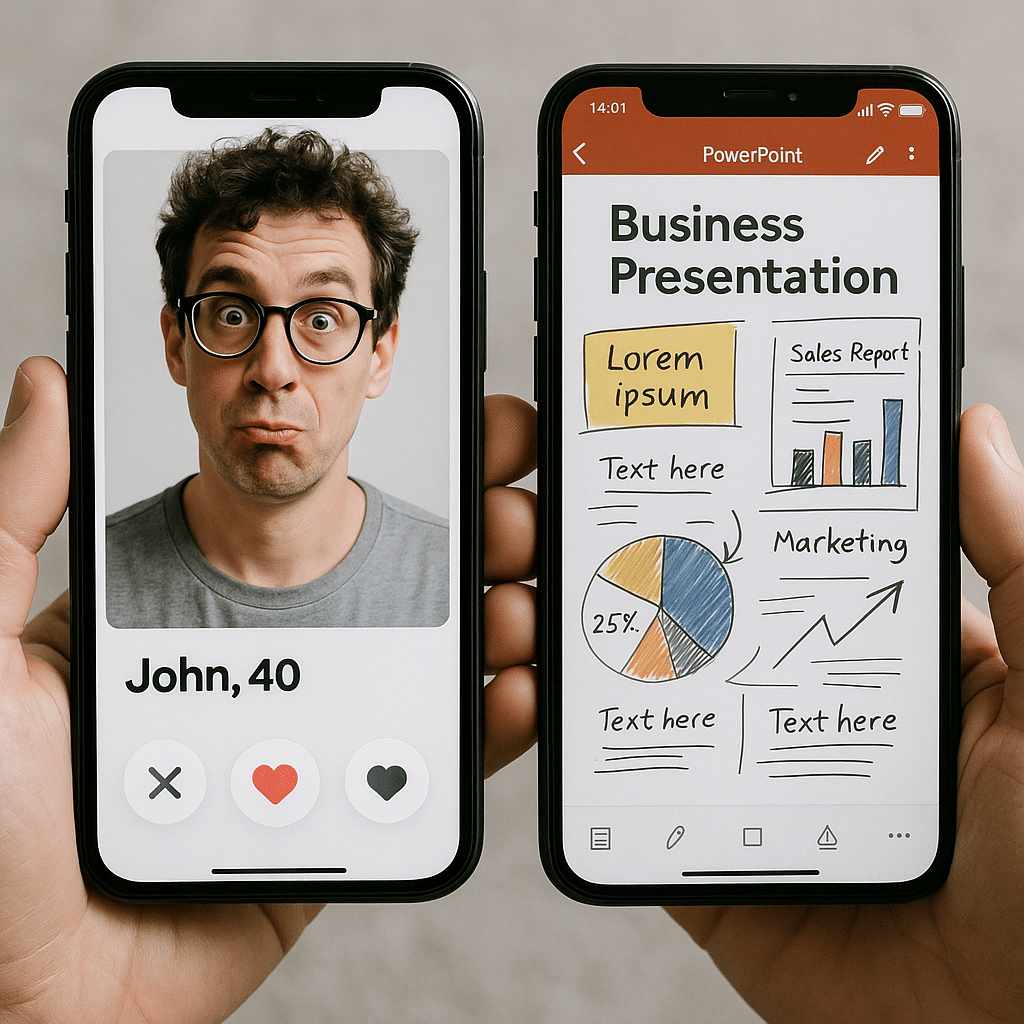They say art imitates life—and sometimes life imitates art.
But your professional life might be imitating your dating life.
And not always in a good way.
Let me explain.
Why “Hey” Doesn’t Get to Happily Ever After
Eleven years ago, I was fed up with online dating.
After a seemingly endless stream of messages that fell into all the categories recently featured in TIME’s article, “The Worst Opening Lines to Use on Dating Apps and What to Say Instead”—think: “hey,” “ur hot,” or bizarrely vague one-liners—I was ready to take a break. I logged in one last time, planning to delete my inbox and take down my profile.
But then… one message caught my eye.
Not because it was witty or over-the-top. In fact, it stood out more for what it didn’t say:
- No eyeroll-worthy abbreviations.
- No misspellings.
- No lazy “u up?” vibes.
The subject line and internal message were well-written, with real punctuation, full sentences, and even—gasp!—a thoughtful question about something in my profile.
And his profile was respectably complete instead of the all-too-common blank page save “I don’t like to talk about myself so if u wanna no something about me just ask,” (be still my heart…), and a respectable headshot that didn't likely double as a mugshot.
Today, I might’ve assumed it was written by a ChatGPT bot trying to sound human.
But back then, it stood out because it felt… normal.
So I responded. That message led to a conversation… a year later I married him and the rest, as they say, is history.
And all of it started with an opening line that made me want to keep reading/listening.
What’s That Got to Do with Business?
Everything.
Because just like in dating, your first impression in business matters more than you think.
Whether you're introducing yourself in a job interview, kicking off a presentation, starting a staff meeting, or making “getting-to-know-you” conversation at a networking event, people are constantly evaluating you based on your first impression, and opening line.
- Do you sound clear or confusing?
- Confident or awkward?
- Intentional or wishy-washy?
- Genuine or canned?
- Interesting and interested, or “meh”?
That first impression is like an invisible “swipe”—and your audience is deciding, right then and there, whether to lean in or tune out.
That’s why in my book, Speaking to Influence: Mastering Your Leadership Voice, I call it the “60-to-60 Rule”:
→ In the first 60 seconds, you’re going to set the audience's expectation for the value you’re going to bring to the next 60 minutes of their lives.
(And frankly, nowadays, it’s probably more like SIX seconds, not sixty.)
Point being: It doesn’t matter how brilliant the rest of your pitch is if no one’s listening after your first sentence.
And unfortunately, too many people default to business versions of bad dating app openers:
- “So yeah, I guess I’ll just start…” (Probably the same thing you said for your middle school book report.)
- “Umm, thanks for being here, I’m not really sure what to say…” (Then don’t.)
- “I know this might be boring, but bear with me…” (Swell, even YOU don’t like your own topic.)
- “I’ll do my best to keep this short.” (Here’s a thought: do your best to keep it GOOD.)
- Or just reading the opening slide verbatim in a monotone voice. (Thanks, but I’m literate. Email the deck to me and let’s save an hour.)
Those are the professional equivalent of “hey,” as the entirety of your first message on a dating app.
And they kill your credibility before you’ve even started.
Let’s Break It Down: Where Your Opener Really Matters
1. Business Presentations
Whether you’re pitching to a prospective investor or client, leading a workshop, or presenting quarterly results to leadership, you’ve got seconds to command the room. This is a common discussion topic among my executive coaching clients.
An opening that’s dry, confusing, or cliché won’t just make eyes glaze over—it can cost you real results.
Try one of these instead:
- Start with a provocative question
- State in one sentence why this conversation is essential
- Use a relevant stat or metaphor
- Share a quick personal story that tees up your core point
The goal isn’t to impress. It’s to connect and compel.
2. Weekly Staff Meetings
No one wants to sit through yet another “okay, let’s get started” sigh, where people spend 10 minutes figuring out who’s talking and what the point is.
A clear, intentional opener in your team meetings sets the tone for engagement. It signals:
- We’re focused on a clear objective/goal.
- This matters… a lot.
- This is worth their time, so they should pay attention and not multitask.
Even a simple agenda preview like:
“We’ve got 30 minutes to solve X and make a decision on Y—here’s what you need to know,”
…makes everyone more likely to participate (and less likely to scroll messages or sports course under the table).
3. Job Interviews
The dreaded, “So, tell me about yourself…” moment is a very common jumping-off point in my Quantum Leap executive transition coaching program.
That’s your online dating inbox moment. The interviewer is deciding whether to keep reading—or move on.
A few months ago when my older son was interviewing for jobs in anticipation of graduating from college, I warned him about this question too.
He followed my advice and reported back:
“When she asked, I just said, ‘I’m sure you’re looking for something specific with that question, but I don’t know what it is, so instead of me wasting your time with a bunch of stuff you don’t actually care about, can you be more specific so I can give you an answer that’s more useful for both of us?’”
“How did she respond?” I asked.
“She got a huge smile on her face and said, ‘I love that answer! Okay, well, let’s do this instead…”
He’s now gainfully employed with that bank. (*Whew!*)
Yes, he answered a question with a question, but ironically, he stood out because his response “read between the lines” and actually solved her problem.
He wasn’t louder or more technically detailed.
He was more confidently intentional.
How to Make Them Want to Know More
The best opening lines—whether in love or leadership—make the other person say:
“That’s interesting… tell me more.”
That’s the goal. Not a full download. Not a mic drop. Just enough of a spark to earn the next moment of their attention.
Ask yourself:
- Would you want to keep listening to this?
- Could someone repeat your opening line five minutes later and remember what you do?
- Does it show that you care about what you’re saying?
Because if you don’t sound interested in your own message, why should anyone else be?
Final Thought: You’re Always Being Evaluated
Whether it’s on an app or in an interview, an elevator or a boardroom, your opener shapes the trajectory of the entire interaction.
So no more “hey” flatlining. No more robotic intros. No more nervous, clumsy rambling.
Be real. Be intentional. And be ready—because you never know when your next big opportunity (personal or professional) is waiting on the other side of a better opening line.



